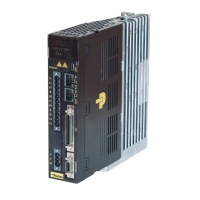Parker Hannifin
P Series User Guide 109
5.2.2 Actual Position
The actual position of the motor/load is the drive’s response to the commanded position,
and is measured with the feedback device. The profile resulting from the actual position
across time is the position response.
To view the actual position, also use the drive support tool software.
The difference between commanded and actual positions is called position error.
Even when the system is properly tuned, the position error can still be quite significant due
to a combination of factors such as the desired profile, the motor's limitation, the dynamic
characteristics of the system, etc. For example, if the commanded velocity is higher than
the maximum velocity the motor can physically achieve, the actual position will always lag
behind the commanded position. Under these circumstances, a position error will
accumulate no matter how high the gains are set.
5.3 Servo Response Overview
5.3.1 Stability
The first objective of tuning is to stabilize the system. The formal definition of system
stability is when a bounded input is introduced to the system, the output of the system is
also bounded. What this means to a motion control system is if the system is stable, and
the position set-pint is a finite value, the final actual position of the system is also a finite
value.
In contrast, if the system is unstable, no matter how small the position set-point or how little
a disturbance (motor torque variation, load change, noise from the feedback device, etc.)
the system receives, the position error will increase exponentially in almost all cases. In
practice, when the system experiences instability, the actual position will oscillate in an
exponentially diverging fashion as shown in Table 38.
One common misperception is that whenever there is oscillation, the system is unstable. It
is important to recognize that a system is considered stable if the oscillation finally
diminishes (damps out), even if it takes a long time.
5.3.2 Position Response Types

